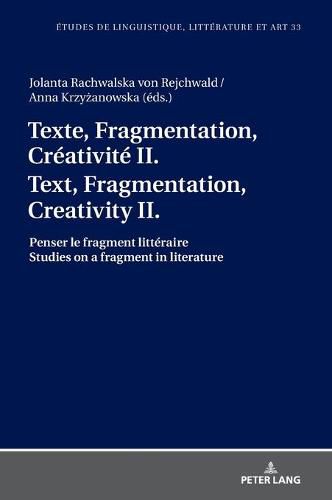Readings Newsletter
Become a Readings Member to make your shopping experience even easier.
Sign in or sign up for free!
You’re not far away from qualifying for FREE standard shipping within Australia
You’ve qualified for FREE standard shipping within Australia
The cart is loading…






This title is printed to order. This book may have been self-published. If so, we cannot guarantee the quality of the content. In the main most books will have gone through the editing process however some may not. We therefore suggest that you be aware of this before ordering this book. If in doubt check either the author or publisher’s details as we are unable to accept any returns unless they are faulty. Please contact us if you have any questions.
L'oeuvre litteraire peut etre apprehendee comme un espace ou agissent simultanement deux forces opposees. D'une part, il s'agit des forces de decomposition qui travaillent sa structure, augmentant l'entropie du systeme textuel; de l'autre, il y a des forces de reequilibrage qui tendent a relier, a federer les parties disjointes afin de reussir une (im)possible unite. Les travaux developpes dans ce livre etudient differents aspects du fonctionnement formel et semantique du fragment dans la litterature francaise et francophone. Ils demontrent que la decomposition de la forme ne vise pas la destruction de l'oeuvre, mais permet de faire ressortir son potentiel de recreation.
A literary work can be considered as a place under the influence of opposing forces. On the one hand, there are deconstructing forces which, by affecting the structure, interfere with its continuity; on the other hand, there are counteracting forces that seek to connect separated parts to create a new unity. The contributions in this book examine the formal and semantic functioning of a fragment in French and Francophone literature. They prove that the decomposition of form does not cause the destruction of the work, but releases all its creative potential.
$9.00 standard shipping within Australia
FREE standard shipping within Australia for orders over $100.00
Express & International shipping calculated at checkout
This title is printed to order. This book may have been self-published. If so, we cannot guarantee the quality of the content. In the main most books will have gone through the editing process however some may not. We therefore suggest that you be aware of this before ordering this book. If in doubt check either the author or publisher’s details as we are unable to accept any returns unless they are faulty. Please contact us if you have any questions.
L'oeuvre litteraire peut etre apprehendee comme un espace ou agissent simultanement deux forces opposees. D'une part, il s'agit des forces de decomposition qui travaillent sa structure, augmentant l'entropie du systeme textuel; de l'autre, il y a des forces de reequilibrage qui tendent a relier, a federer les parties disjointes afin de reussir une (im)possible unite. Les travaux developpes dans ce livre etudient differents aspects du fonctionnement formel et semantique du fragment dans la litterature francaise et francophone. Ils demontrent que la decomposition de la forme ne vise pas la destruction de l'oeuvre, mais permet de faire ressortir son potentiel de recreation.
A literary work can be considered as a place under the influence of opposing forces. On the one hand, there are deconstructing forces which, by affecting the structure, interfere with its continuity; on the other hand, there are counteracting forces that seek to connect separated parts to create a new unity. The contributions in this book examine the formal and semantic functioning of a fragment in French and Francophone literature. They prove that the decomposition of form does not cause the destruction of the work, but releases all its creative potential.